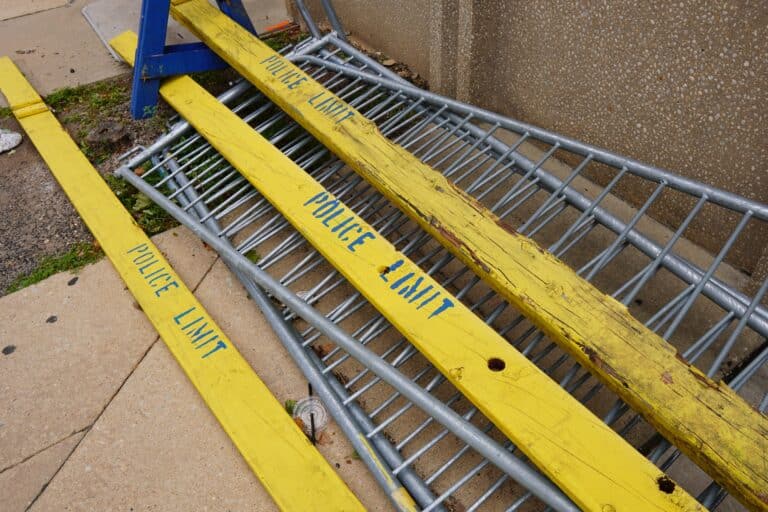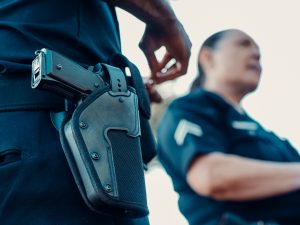Police officers responding to the Lewiston, Maine shooter’s deteriorating mental health considered but decided against using the state’s temporary gun confiscation law in the months leading up to the attack, according to newly released recordings.
Dash camera footage from the Sagadahoc County Sheriff’s Office confirms that officers called to conduct wellness checks on the Lewiston shooter resisted using the state’s “yellow flag” law—which allows police to temporarily remove firearms from a person deemed a threat by a judge—out of fear of instigating a violent encounter.
“Then there’s the yellow flag laws,” Sagadahoc County Sheriff’s Seargent Aaron Skolfield said in the video. “So, when there’s someone who’s a danger to themselves or others, there’s a process we’re supposed to go through to seize their weapons if they are deemed a danger to themselves or others. So that, you know, that obviously is a hurdle we have to deal with, but at the same time, we don’t want to throw a stick of dynamite into a pool of gas either and make things worse.”
The footage is the latest revelation in the series of missed opportunities to avert the October 25 attacks in Lewiston, which became the deadliest mass shooting in Maine’s history. It underscores how the shooter was able to retain access to firearms despite making violent threats and exhibiting behavior that was concerning enough to prompt his Army reserve unit to order his temporary commitment to a psychiatric facility. It comes as instances of police inaction in response to mass shooting threats have increasingly drawn public scrutiny in recent years.
At the same time, it highlights the deficiencies of emergency gun confiscation laws like Maine’s yellow-flag statute and those of nearly two dozen other states. Even when such laws are on the books, and even if law enforcement is aware of their existence, their efficacy still depends on officers initiating a potentially volatile encounter with an already unstable person—something police may be hesitant to do.
The video footage, which the Portland Press Herald first obtained through a FOIA request, documents a September 16 phone call between Skolfield and Army Reserve Captain Jeremy Reamer—the shooter’s Army supervisor—moments after Skolfield unsuccessfully attempted a wellness check at the shooter’s home. The conversation featured the two men grappling with different options about how best to respond to the shooter’s increasingly erratic behavior, at which point Skolfield brought up Maine’s so-called yellow flag law.
The recording also showcased Reamer’s concern that the shooter was not receiving any follow-up psychiatric treatment after his involuntary stay at an Army mental hospital over the summer.
“He’s refusing any real medical treatment. I mean, we got him as much as we could,” he said. “You know, you can lead a horse to water, but if he’s not gonna drink it, then there’s not much we can really do.”
The recording also featured Skolfield stating that he preferred to keep his handling of the shooter’s threatening behavior informal and off the record due to his being part of a “big family” in the area.
“I mean, I’ve kept everything off the scanner,” he said. “Like I said, they’re a big family in this area, and I didn’t want to say on the radio that I’m off at a particular address and have them listening on the scanner and go, ‘Okay, what’s going on.’ But I think I can talk to [the shooter’s brother] and say, ‘Hey, I just want to make sure you’ve got his guns.'”
The failure of both the sheriff’s office and the U.S. Army to adequately address the threat posed by the shooter in the months leading up to the attack has drawn calls for greater oversight from Maine’s elected officials. Governor Janet Mills (D.) ordered the formation of an independent commission with subpoena powers last month to investigate how officials handled the shooter’s warning signs. Meanwhile, at the federal level, the U.S. Army Inspector General’s office has announced it will investigate the case at the behest of Maine’s federal Senate delegation.
The Sagadahoc County Sheriff’s Office, for its part, released the findings of its own independent, third-party review of its responses to the shooter’s behavior earlier this month. The 93-page report concluded that the office’s handling of the case was “reasonable under the totality of the circumstances.” In particular, it also found that Skolfield acted properly by not attempting to use the yellow flag law because he did not have probable cause to take the shooter into protective custody at the time of his wellness check—a prerequisite for initiating a yellow flag order under the law.
“[I]t was reasonable for them to conclude under the totality of the circumstances both that Mr. Card did not then pose an imminent risk of self-harm or harm to others, that there were insufficient grounds to take Mr. Card into protective custody or to take other actions, and that deferring the monitoring of Mr. Card’s wellbeing, including guidance toward a mental health evaluation and treatment, to third parties while emphasizing the availability of Sheriff’s Office resources if they should be needed thereafter, was objectively reasonable,” the report reads.
The report recommended the Sheriff’s Office “continue and enhance” its mental health programs, utilize a “mental health liaison” more frequently, and create a “multijurisdictional and multidisciplinary mental health response team.”






